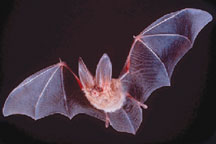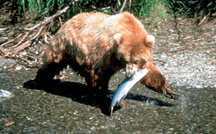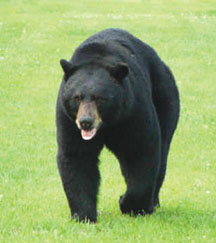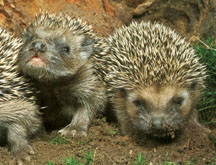
The 'big sleep' animals go into
The environment around us is constantly changing, and we humans have
evolved ways to survive through such changes. But, have you ever
wondered how our friends in the animal kingdom manage to survive in
adverse environmental conditions such as extreme cold or heat, which
often leads to shortages of food and water?

Some animals are naturally equipped to survive in such situations,
and are able not merely to endure, but actually thrive in conditions
which are unbearable for most other life forms. Some other animals do so
by what is popularly known as hibernation.
You may have heard the word hibernation being used often in
conversations because, when some people have not been seen around for a
while and suddenly make an appearance, people sometimes tend to ask them
whether they have been in 'hibernation'. Well, hibernation is actually
something animals resort to, so, let's check out what exactly
hibernation means.
What is hibernation?
Hibernation, also known as the 'big sleep', is not the same as the
nightly sleep or occasional nap we humans or for that matter, animals
have. It is much, much more than that. In fact, during hibernation, body
temperature drops, the heartbeat slows and the animal seems to be
scarcely breathing! The animal uses hardly any energy during this 'big
sleep'.
How hibernation takes place
Animals have to prepare themselves for hibernation well in advance.
They cannot suddenly go into hibernation when they encounter harsh
climatic changes overnight, the way we suddenly decide we want to sleep.
Animals need several weeks to condition their bodies to these changes.
The process of hibernation involves a complex series of physiological
changes.

During the weeks of preparation for hibernation, the animal eats more
than normal, in order to build up substantial fatty layers. For example,
bats increase their total body weight by as much as a quarter, during
this fattening-up process.
Extreme hibernators such as hedgehogs undergo many changes. Their
blood's potassium content increases, their reproductive organs decrease
markedly in size, as they will not be needed during the big sleep, and
also some endocrine glands including the thyroid, reduces considerably
in size.
Well, what do you think happens when the animals enter this stage,
especially after loading themselves with extra food to build up fat? The
same thing most of us would undergo when we have loaded ourselves with
food... Feel sluggish of course. By now, they are almost ready for
hibernation in the winter season. Hibernation itself is triggered by a
drop in the environmental temperature below a certain critical level,
for the species concerned.

Once the animals enter hibernation, the breathing rate automatically
decreases dramatically. Some bats take only a single breath every two
hours! Their heart rate also reduces from over 1,000 beats per minute in
a bat in flight, to 25 per minute during hibernation. And when the
heartbeat slows down, the circulatory system too slows down, making its
skin and extremities(hands and feet) cold to the touch. In fact, at such
times, the animal seems as if it is dead.
However, the reality is very much different, to what's visible from
outside. Even though the animal's body is cold outside, the body's
internal regions, especially those nearest the heart, are still warm,
and its vital physiological functions, although slower than normal, are
sufficient for the animal's survival. The animal's body temperature is
controlled by the brain, and does not fall to dangerous levels, even if
the temperatures outside falls to abnormally cold levels.
Wake-up calls...
Ground squirrels, which relinquish(give up) their fat supplies during
hibernation, can awaken from their deep sleep in less than three hours.
During arousal, the anterior (frontal) skeletol muscles get over 16
times more blood than their counterparts in a fully awake animal,
powering their shivering to produce heat for raising the body's
temperature. Waking up from hibernation can be more dangerous than
survival during extreme cold conditions. The danger occurs because
waking up from such a deep sleep needs a significant rise in
metabolic(chemical process) activity.

Fuel is used rapidly to heat the body during the awakening period. As
a result, if a hibernating animal is disturbed and woken by some
unexpected external stimulus (something that rouses to activity ) and
the hibernating animal does not replenish ( fill up again ) its fat
supplies before sinking back into hibernation once more, the animal is
in danger.
There is a danger that in such a situation, the hibernating animal
will prematurely (before time) exhaust ( use up ) its supplies and die.
So, never disturb hibernating animals if you ever come across them
anytime.
What are true hibernators?
True hibernators are animals that sleep or go into hibernation and
never wake up in between, during the period the particular species
generally hibernates. Dormice (ground squirrels and bats) may spend as
much as half the year in hibernation, but they do wake up occasionally
to answer calls of nature and sometimes to even replenish their fat
layers by feeding on whatever suitable nutrients they can find during
winter time.
Hedgehogs however, are considered to be true hibernators, taking
their hibernation to extremes. They do not wake up to even answer a call
of nature. During this long period of inactivity, their internal system
needs to be protected from attacks by the bacteria that inhabit their
guts.
How do you think this is done? By large numbers of white blood cells
that accumulate around their blood vessels and in the stomach lining as
barriers to bacterial invasion.
Are bears true hibernators?
Bears are often said to hibernate, but many scientists feel this is
not strictly correct, because, the physiological process involved is far
less extreme than that of true hibernation. Many scientists therefore
prefer to call the long periods of sleep bears spend in their dens as
'winter sleeping' or 'winter denning' rather than hibernation.
Just like true hibernators, bears too prepare for the winter by
consuming excess amounts of food, in the autumn, especially fruit, to
build up layers of fat. Once they retire to their dens at the onset of
winter, and go to sleep, their breathing and heartbeat rates too drop
significantly.
Their consumption of oxygen too falls to little under 50 per cent of
normal. However, the difference is in the body temperature. While in
true hibernating animals, the body temperature plummets (falls) to only
a little above the environmental temperature in bears, it falls by only
a few degrees.
And what's more, bears often wake up during 'hibernation' and leave
their dens for days at a time. Females are even known to give birth to
cubs during this time, and as scientists and researchers claim, this
would not happen if they were true hibernators.
It is not only in cold winter months that animals go into
hibernation. Some animals hibernate during extremely hot weather. This
process is known as 'Summer hibernation'. We'll check out what this form
of hibernation is all about in our next issues.
Fact file
* Some species such as dormice (domine in French means 'to sleep')
hibernate for up to six months. But they do wake up occasionally.
* Northern Alaska's ground squirrel spends as much as nine months in
hibernation.
* A hibernator's body temperature can fall by as much as 36 degrees
fahrenheit (20 degrees celsius).
* Large amounts of fat are burned as fuel to raise the body
temperature. This is accompanied by intense shivering and muscle
contraction, which also generate heat.
* Much of the heat is derived from a kind of fat known as brown fat,
which contains many energy-producing cells. This substance acts like an
electric blanket, releasing heat to the heart and major blood vessels.
* Ground squirrels have as much as 57 per cent of this brown fat
around their shoulders, 14 per cent in their neck and most of the
balance fat in their thorax.
* American red bat can survive even if its body tissues freeze, when
the outside temperature falls as low as 23 degrees Fahrenheit.
* Some butterflies go into a state of hibernation during winter,
awakening in spring when flowers start to bloom. |


